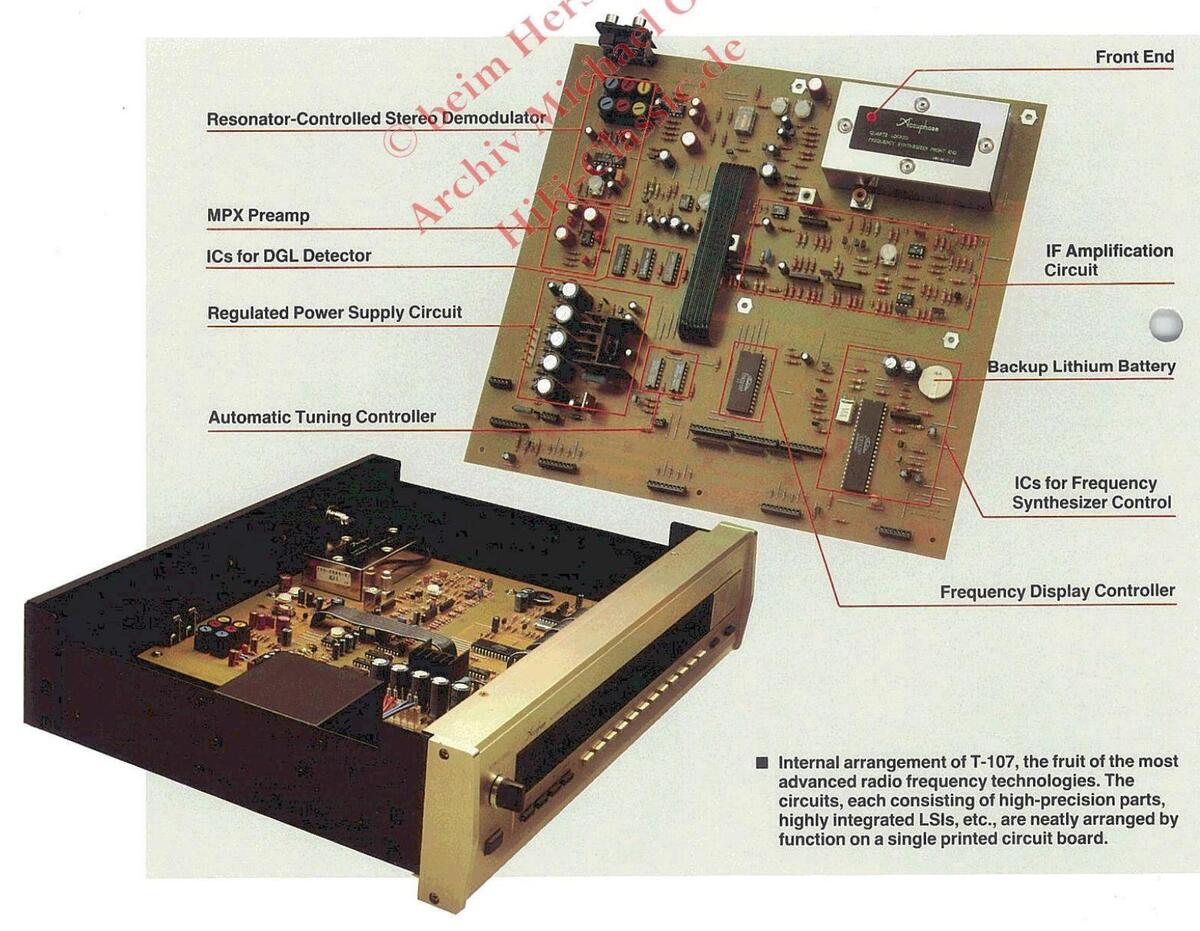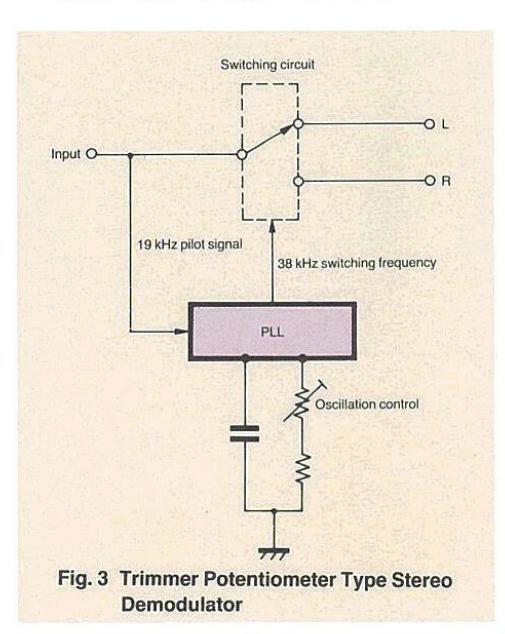
The Accuphase T-107 achieves superb fidelity and stability supported by a newly developed DGL detector with high stability and low distortion, ca latest resonator-controlled stereo demodulator.
Keeping pace with technological progress, electronic tuning systems featuring quartz synthesizers are beginning to dominate the market, outmoding conventional models which depend on variable rotating capacitors. Of particular value in these new systems are the higher tuning accuracy made possible by quartz-controlled precision, the use of memory for effortless station selection, and high resistance to vibration.
The Accuphase T-107 is a sophisticated, quartz-locked synthesizer FM stereo tuner with superb fidelity and signal stability supported by the most advanced electronic technologies available. These include PLL electronic tuning circuitry, a differential gain linear (DGL) detector using the delay time of high-speed C-MOS ICs for low-distortion reception, an advanceddesign resonator-controlled stereo demodulator, and a high-quality audio-frequency amplifier for improved sound quality. That's a lot of electronic terminology-but what it simply means is that not only is the T-107 easy to operate and distinctively designed, it also boasts stable performance, high reliability, and pure sound quality supported by the most up-to-date Accuphase technology
So, sit back, relax, and enjoy music as you like it with the T-107.
ELECTRONIC TUNING SYSTEM REALIZES HIGH TUNING ACCURACY
The highly accurate electronic tuning system in the T-107 receives desired signals with quartz-controlled precision within a remarkable ±0.002%. Furthermore, almost no microphonics or noise is caused by acoustic feedback. This means the tuned frequency channels can be locked in with minimum distortion at the point of highest sensitivity with almost no frequency drift over time or because of temperature changes. And for easy readability, a noise-free digital frequency display is employed.
2 12-STATION RANDOM MEMORY AND AUTOMATIC SWEEP FOR FM RECEPTION
The feather-touch pushbuttons permit random presetting of 12 different FM stations, any one of which can then be instantaneously tuned in at the touch of your finger. Or, the stations can be tuned in manually by pressing the UP/DOWN tuning button which increments/ decrements the frequency in 50 kHz steps (100 kHz in North America and non-European countries). To switch the frequency at high speed,
simply hold the button down. If you change to the automatic tuning mode, each time you press the UP/DOWN tuning button, the tuner searches for the next station and instantly jumps to it.
Tuned stations are locked in with quartzcontrolled precision producing stable FM reception with minimum distortion. Moreover, thanks to a backup battery, the station selections you made are maintained long after the power is turned off.
BOUBLE-TUNED FRONT-END REJECTS INTERFERENCE AND INTERMODULATION
In any tuner, the front-end is virtually its "heart". It performs several critical functions – selects the input signal, amplifies it, and generates and delivers the intermediate frequency signal to the detector. How well this section is designed determines the tuner's sensitive and ability to reject interference. In short, it plays a major role in determining the quality of the tuner's sound. A great improvement in suppressing RF intermodulation was achieved in the T-107's front-end in addition to two stages of double-tuned RF circuitry and a tuned buffer amplifier.

ustment-free electronic technologies, including ully selected linear phase IF filters, and the
Accuphase 1-10/ Synthesizer FM Tuner

NEWLY DEVELOPED DIFFERENTIAL GAIN LINEAR FM DETECTOR AND IF FILTERS WITH FLAT GROUP DELAY CHARACTERISTICS
ne T-107 realizes stable tuning characteristics with minimum distortion and an excellent capture ratio by combining the newly developed DGL (differential gain linear) detector and specially selected intermediate frequency filters with flat group delay time characteristics. The DGL detector incorporates 19 serially connected high-speed C-MOS ICs, as shown in Fig. 1. The phase angle is delayed by 114° to minimize distortion and to obtain the best signal-to-noise ratio. The delay signal that results and the input signal are applied to an exclusive OR circuit. The gate circuit is then closed (with 11, 00) or opened (with 10, 01), according to the electric potential between the two signals. The compression ratio of signals produced by modulation is thus detected digitally (that is, logical multiplication is performed) and sound signals are obtained (Fig. 2). Because the linear range of the delay circuit is extremely wide (±5MHz) and the circuit requires no adjustment, stable and high-grade linear differential gain characteristics can be
obtained. > IF filters are provided: NORMAL and NARROW. Should radio interference be strong, the NARROW IF filter can be selected by the front panel switch, thus allowing reception with an emphasis on selectivity.

5 NEWEST, RESONATOR-CONTROLLED STEREO DEMODULATOR
For FM broadcasting, stereo signals are transmitted with a 38 kHz subcarrier by alternately switching left- and right-channel signals. Therefore, in an FM tuner, generation of matching signals that perfectly synchronize with this 38 kHz subcarrier is necessary to separately
demodulate the received left- and right-channel signals. This is done using a switching circuit. If a phase difference exists between the tuner's signals and those of the transmitted subcarrier, channel separation degrades and components of the left- channel signals mix with those of the right-channel signals or vice-versa. The result is narrower channel separation and diminished sound quality.
To realize near-perfect performance characteristics of the FM stereo demodulator, the tuner's internal oscillation circuit is locked by the PLL circuitry using the synchronizing pilot signals contained in the input signals (see Fig. 3). This is the way accurate 38-kHz switching signals are obtained. For its internal oscillation circuit, the T-107 employs a new combination of a ceramic resonator with a variable reactance circuit governed by the control voltage (see Fig. 4). This means that accurate switching signals can be obtained in a locked frequency range which is narrower than conventional ranges. This stereo demodulator circuit has the following features
lowing features. (a) No adjustment of the stereo demodulator circuit is required and initial performance characteristics are maintained for a long time.
- (b) Stereo channel separation which is relatively unaffected by temperature changes, line voltage fluctuations, etc.
- (c) A locked frequency range (capture range) which is narrower than conventional ranges, reducing distortion due to beat interference at high frequencies.

The meter indicates the strength of the incoming radio signal as well as detects the amount of multipath reception. The input signal strength can be directly read in dBf. When MULTIPATH function is specified, if the pointer stays within the "CLEAR" range, minimum multipath reception is indicated and therefore good reception conditions exist.
OTHER FEATURES
Other available features include a multiplex noise filter to reduce noise when receiving a weak FM stereo station; a muting switch to eliminate interstation noise, and a level control to equalize the tuner output level with other program sources.
TWO COLORS ARE AVAILABLE FOR THE FRONT PANEL: CHAMPAGNE GOLD AND BLACK
The front panel comes in champagne gold, the traditional color of Accuphase products. A black front panel is also available as Type T-107B.


Synthesizer FM Tuner
Accuphase

- POWER switch
- OUTPUT LEVEL control knob
- SIGNAL/MULTIPATH meter
- TUNED indicator
- STEREO indicator
- Digital frequency display
- TUNING buttons
- METER function selector switch
- MUTING (interstation noise silencing) switch
- Multiplex noise FILTER
- SELECTIVITY selector switch
- Memory STATION selector buttons
- Station MEMORY button
- TUNING MODE selector switch
PERFORMANCE GUARANTY.
MONOPHONIC PERFORMANCE
- FREQUENCY RANGE: 87.5 MHz-108.0 MHz SENSITIVITY:
- Usable Sensitivity
- Usable Sensitivity: 11 dBf (IHF) 50 dB Quieting Sensitivity: 17 dBf (IHF) VOLTAGE STANDING WAVE RATIO: 1.5 SIGNAL TO NOISE RATIO AT 80 dBf: GNAL TO NOIS
- SU GB (A-weighted) TOTAL HARMONIC DISTORTION: with SELECTIVITY switch set to NORMAL 80 dBf 20 Hz 1,000 Hz 10,000 0.04% 10.000 Hz
- INTERMODULATION DISTORTION: Will not exceed 0.01% (Antenna input 80 dBf, ±75 kHz deviation, 14 kHz and 15 kHz = 1:1)
- FREQUENCY RESPONSE: +0, -1.0 dB, 10 Hz to 16,000 Hz SELECTIVITY: (IHF) With SELECTIVITY switch set to NARROW
- switch set ... NORMAL NAHr 100 dB Alternate Channel: 70 dB
- RF INTERMODULATION: 80 dB
- SPURIOUS RESPONSE RATIO: 100 dB IMAGE RESPONSE RATIO: 80 dB AM SUPPRESSION RATIO: SUBCARRIER PRODUCT RATIO: 40 dB SCA REJECTION RATIO: 80 dB OUTPUT N 1.0 Volt at ±75 kHz deviation STEREOPHONIC PERFORMANCE SENSITIVITY: 40 dB Quieting Sensitivity: 29 dBf (IHF) 50 dB Quieting Sensitivity: 37 dBf (IHF) SIGNAL-TO-NOISE RATIO AT 80 dBf: TOTAL HARMONIC DISTORTION With SELECTIVITY switch set to NORMAL 80 dBf input at ± 75 kHz deviation 20 Hz 1,000 Hz 10,000 Hz 0.04% 0.04% 0.08% INTERMODULATION DISTORTION: Will not exceed 0.03% (Antenna input 80 dBf, ±75 KHz deviation, 9 kHz and 10 kHz = 1:1) FREQUENCY RESPONSE: 10 -10 dB 10 Hz to 16 000Hz STEREO SEPARATION: SIEREO SEPARATION: 100 Hz 1,000 Hz 10,000 Hz 50dB 50 dB 40 dB STEREO AND MUTING THRESHOLD: 20 dBf
GUARANTY SPECIFICATIONS
- GENERAL
- ANTENNA INPUT:
- FM: 75-ohm unbalanced(with 300-ohm balanced
- TUNING SYSTEM:
- Quartz-lock Frequency Synthesized Tuning System Preset Tuning at random memory for 12 stations FM DETECTOR:
- ential Gain Linear Detector) OUTPUT IMPEDANCE:
-
Audio output FIXED: 200 onns Audio output CONTROLLED: 1.25 kohms max. METED
- SEMICONDUCTOR COMPLEMENT:
- POWER SUPPLY AND POWER CONSUMPTION:
- Compatible to 100/117V and 220/240V 50/60 Hz
- operation Consumption: 12 Watts DIMENSIONS:
- DIMENSIONS: 445 mm (17-1/2 in) width, 107 mm (4-3/8 in) max. height, 330 mm (13.0 in) depth WEIGHT:
- 5.8 kg (12.8 lb) net, 9.8 kg (21.6 lb) in shippina






